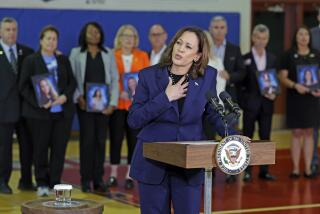Grisly Photos Give Students Reality Check : Schools: Two doctors give a slide show depicting injuries from gunshots and stabbings. It is designed to strip romance from violence and counter TV images.
- Share via
The ninth-graders gasped at the first bloody image of a face partially blown away.
After watching a few dozen more color slides of the bloody legacy of street violence--severed limbs, open wounds, punctured hearts--the images still seemed to shock the several hundred students.
That was the plan. The two emergency room trauma surgeons, Dr. Edward E. Cornwell and Dr. Juan A. Asensio, were at Jefferson High School on Friday to shock.
Tired of sewing up one body after another at County-USC Medical Center, the surgeons hoped that showing close-up views of body parts torn by bullets would strip any romantic notions about violence that the young South-Central students might hold.
Cornwell had given “shock talks” to students in Washington, and Asensio had done the same thing in Philadelphia. But this was the first time either of them spoke to students in Los Angeles.
“We needed to show you reality,” Cornwell told the students. “It’s not what you see on television.”
To bring the message home, the students were shown slide after slide of bellies blown apart by bullets, shoulders without arms and chest cavities opened by a surgeon’s scalpel. Asensio also included some operating room shots of soldiers wounded in Vietnam.
Among the statistics the two use: More Americans died of gunshot wounds in 1986 and 1987 than the entire 8 1/2 years of the Vietnam War.
“That is what a gun does to you,” Asensio said after one particularly grisly slide of a severed limb produced horrified gasps from the students.
Cornwell believes that reaching out to young people while they are still at an impressionable age may save their lives as surely as treatment in an emergency room.
“Where can we make the most difference?” he asked. “That’s right: in prevention.
“The reason we are here today is that we are seeing more and more trauma among young people,” Cornwell said.
This was the first outreach effort for Cornwell since he and trauma surgeons, members of the African American-oriented National Medical Assn., urged other surgeons to get involved in similar efforts in a paper published last month in the Journal of the American Medical Assn.
The article urged surgeons to get involved in prevention, counseling and outreach programs. Otherwise, Cornwell wrote, trauma surgeons will slip into the role of “glorified medics in an unwinnable war, patching up and resuscitating one victim after another” without an impact on the cause of the injuries.
Cornwell said injuries from violent acts are nothing short of a “public health epidemic” among the young. He said gunshot wounds killed more children up to age 19 than all diseases combined.
The most common cause of death for African American males ages 15 to 24 is homicide caused by gunshot wounds, he added.
In choosing Jefferson High to carry their message, the physicians found a receptive audience. Just about every teacher and many of the students have personal stories about violence.
The slide show was part of a freshman orientation program. Because Jefferson is a year-round school, Friday was the first day of school for this group of students.
Fearing that the images might be a little too strong, they cleared their talk with school administrators and teachers after giving them a preview.
The school is considered something of a neutral zone and relatively free of violence. But the neighborhood around it is a battleground and the turf of numerous gangs, students and teachers said.
Julie Revilla, a school counselor who helped organize the slide show, said a teen-ager ran through the school gates last year and collapsed in her arms, a bullet in his chest. On another occasion, she said she called the parents of a student whose grades had dropped sharply.
“It turned out they had just lost their first son,” Revilla said. “The whole family had been traumatized.”
A 14-year-old girl named Tiana, asked after the slide show if she had family members who had been injured by knives or guns, mentioned her brother, sister, uncle and cousin.
She said she thought the message had gotten across. “It should have an effect,” she said.
As for Cornwell, he said he wasn’t sure what kind of an effect the talk would have. He said he may never know.
“You do your part, and hope you hit a few people,” he said.
More to Read
Sign up for Essential California
The most important California stories and recommendations in your inbox every morning.
You may occasionally receive promotional content from the Los Angeles Times.










